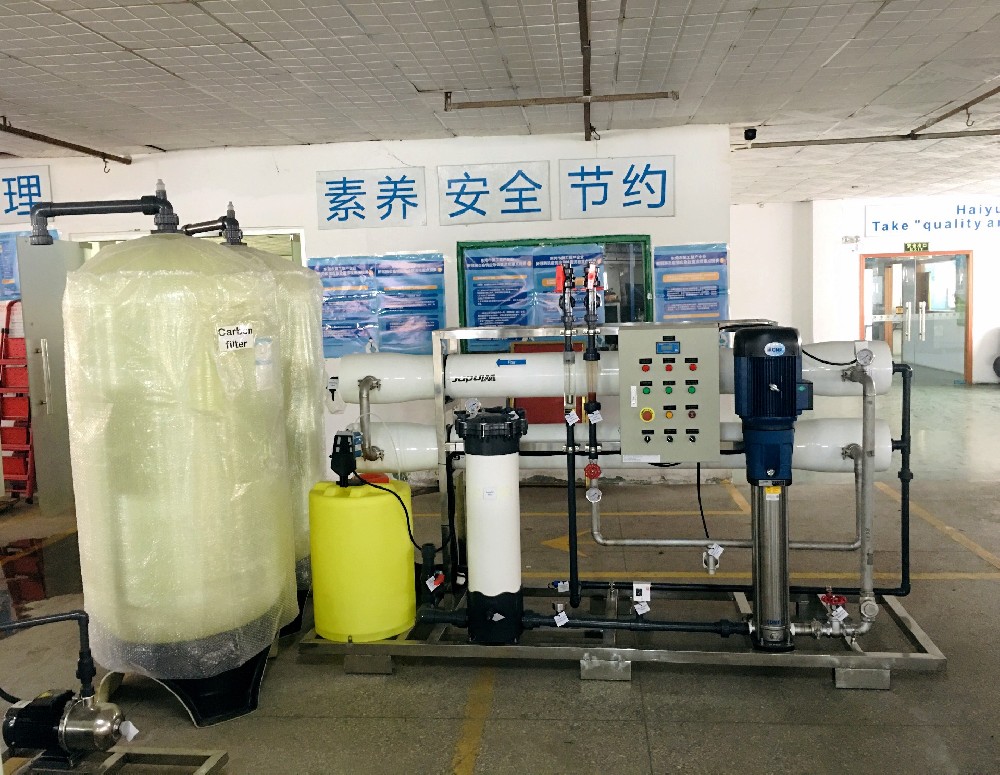
Wechat/Whatsapp:
+8613798883773

Wechat/Whatsapp:
+8613798883773
HYWATER Reverse Osmosis plant/system


Common knowledge about RO plant Unit conversion of the size and water flow of Reverse osmosis membrane In the water treatment process, the unit of length is generally mm (in=inch, ft=foot): 1in=25.4mm, 1ft=304.8mm, 12in=1ft Reverse osmosis membrane aperture: 10-6in=2.54x10-6mm Area: 1ft2=144in2 =929x10-4m²=92903mm², 1 in2=6.45 x10-4m²=645.2 mm²; Flow: UK gpd (gal/d, gallon/day) = 4.546L/d=5.26*10-5L/s; US gpd (gal/d, gallon/day) = 3.785L/d=4.381*10-5L/ s Pressure: 1b/in2 (psi, pound force/square inch)=0.0703kgf/cm², legal unit: 1pa=1N/m², 1Mpa=106pa, 1psi=6.895kpa=6.895x10-3Mpa; when the pressure that reverse osmosis can withstand is 600psi, it is 4.14Mpa. 1bar (commonly known as 1kg)=0.1Mpa; 1mmHg=0.1333kpa; Free chlorine content <1ppm, that is, free chlorine <1mg/L. Conductivity Meter Calibration Conductivity calibration can be calibrated with 0.01mol/L and 0.02mol/L potassium chloride solutions. The specific method: place the conductivity electrode to be calibrated in 0.01mol/L or 0.02mol/L potassium chloride solution, and use a precise constant temperature The potassium chloride solution is kept at different temperatures in the water bath, and the measured conductivity is compared with the standard data, the electrode constant of the unknown constant electrode can be measured, and it can also be checked. When measuring the conductivity, try to make the temperature close to 25°C for easy comparison. If there is some deviation, it can be corrected at 10-40°C. The online conductivity meter of RO plant can also be used as a signal for process control to regulate the dosage. For example, when adding ammonia to pure water to increase the pH to prevent corrosion, the pH signal cannot be used to keep the pH of the water between 8.8-9.4, or between 9.0-9.6, but the change in conductivity of the water can easily control ammonia. 's addition. When controlling the dosage of trisodium phosphate in boiler water, when the electrical conductivity of the boiler is less than or equal to 10uS/cm, the phosphate radical should be 0.3-2.0 mg/L. Unload the membrane elements 1) First, remove the external hard pipes at both ends of the pressure vessel. If necessary, refer to the pressure vessel manufacturer's sketch, and mark all the removed parts with numbers and put them in order. 2) Remove the vessel end plate assembly from both ends of the pressure vessel. 3) Push the RO element out of the pressure vessel from the water inlet end of the element. Push out one element at a time. When the element is pushed out of the pressure vessel, catch the element in time to prevent damage to the element or injury to personnel. Load the membrane elements 1. Remove the end plate and thrust ring from the system pressure vessel. 2. Rinse the opened pressure vessel with clean water to remove dust and deposits. 3. Insert the end of the membrane element without the brine seal from the direction of the water inlet of the pressure vessel, and push the element in about halfway. 4. Verify that the brine seal on the element strainer is oriented correctly. That is, the opening direction of the sealing ring should face the water inlet direction. Insert the connecting joint between the elements into the central pipe of the water permeation of the element. Before installing the joint, apply a small amount of glycerin on the O-ring of the joint (except for special circumstances that are not allowed). 5. Install the second component and the connector in sequence, being careful to hold the component without placing the connector on the component's weight, and push the component into the pressure vessel until the component is approximately halfway out of it. 6. Repeat steps 4 and 5 until all elements fit into the pressure vessel, the length of the element and pressure vessel determining the number of elements in a single pressure vessel. 7. Install a thrust ring on the concentrate end of the pressure vessel, refer to the pressure vessel manufacturer's schematic to locate the thrust ring. 8. Install the end plates at both ends of the pressure vessel as follows: a) Carefully position the concentrated end plate of the pressure vessel, align the element and push in the end plate assembly, carefully place an O-ring on the transition joint (adapter) between the element and the end plate, insert the transition joint into the element to Avoid twisting or flipping the O-ring. b) Rotate to adjust the alignment of the end plate assembly with the external connection tube. c) Install the end plate snap rings according to the pressure vessel manufacturer's schematics. d) Push the RO element from the inlet side to the concentrate side. e) Before installing the water inlet end plate, it is recommended to adjust the gap between the element and the end plate with the adjusting piece. This step can help prevent component play and component-to-component shock during system startup and shutdown. f) Install components in the same way as steps a) to e) for each pressure vessel in the system. 9. Connect all external lines of RO plant. More inquiries related to RO plant please contact: Mob& Wechat& WhatsApp: (+86)13544774483 Email: sales010@water-sy.com We will provide high-quality, all-round comprehensive professional services for project consulting, system design, manufacturing, installation and commissioning, personnel training, etc
